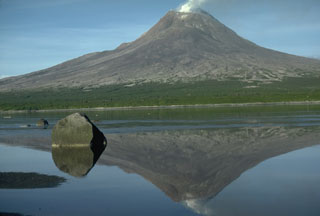Report on Augustine (United States) — March 1976
Natural Science Event Bulletin, vol. 1, no. 6 (March 1976)
Managing Editor: David Squires.
Augustine (United States) Several small earthquake swarms
Please cite this report as:
Global Volcanism Program, 1976. Report on Augustine (United States) (Squires, D., ed.). Natural Science Event Bulletin, 1:6. Smithsonian Institution. https://doi.org/10.5479/si.GVP.NSEB197603-313010
Augustine
United States
59.3626°N, 153.435°W; summit elev. 1218 m
All times are local (unless otherwise noted)
A seismic array continued in operation on Augustine Island during March. The only known activity during this period was normal degassing and several earthquake swarms, with most magnitudes in the 1-2 range.
Geological Summary. Augustine volcano, rising above Kamishak Bay in the southern Cook Inlet about 290 km SW of Anchorage, is the most active volcano of the eastern Aleutian arc. It consists of a complex of overlapping summit lava domes surrounded by an apron of volcaniclastic debris that descends to the sea on all sides. Few lava flows are exposed; the flanks consist mainly of debris-avalanche and pyroclastic-flow deposits formed by repeated collapse and regrowth of the summit. The latest episode of edifice collapse occurred during Augustine's large 1883 eruption; subsequent dome growth has restored the edifice to a height comparable to that prior to 1883. The oldest dated volcanic rocks on Augustine are more than 40,000 years old. At least 11 large debris avalanches have reached the sea during the past 1,800-2,000 years, and five major pumiceous tephras have been erupted during this interval. Recorded eruptions have typically consisted of explosive activity with emplacement of pumiceous pyroclastic-flow deposits followed by lava dome extrusion with associated block-and-ash flows.
Information Contacts: J. Kienle, Univ. of Alaska.

